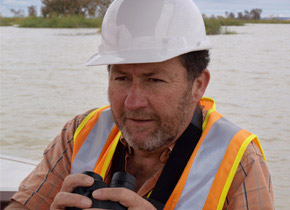Media releases
New research highlights threats to international freshwater systems
Posted: Tuesday 4 December 2018
The threats to freshwater biodiversity internationally have reached dangerous levels, according to a new research paper co-authored by Professor Peter Gell of Federation University Australia.
The paper in the prestigious journal Biological Review provides an update on the challenges to freshwater conservation across the world and reveals 12 emerging threats to aquatic ecosystems.
Peter Gell, Professorial Research Fellow and Associate Dean for Research in the School of Health and Life Sciences, is one of 16 authors from six countries to contribute to the paper ‘Emerging Threats and Persistent Conservation Challenges for Freshwater Biodiversity’, which was published online last month.
“This paper is firstly an update of a paper that spelt out clearly the extremely high level of threat human activities are having on freshwater biodiversity worldwide,” Professor Gell said.
“The 2006 paper had an extremely high impact across the conservation and aquatic ecology fields with over 2300 citations.
“The paper just published revisits the level of threat posed by the overexploitation of freshwater resources, water pollution, flow modification, habitat degradation and loss, and invasive species identified in the first paper.”
Professor Gell said freshwaters have a high relative proportion of the world’s vertebrate species yet their biodiversity is under greater threat than that on land or in the oceans.
“Freshwater science is only beginning to understand the threats posed by the by-products of our advanced technologies,” Professor Gell said.
“The new paper identifies pharmaceuticals such as antibiotics, engineered nanoparticles, and microplastics as emerging threats in addition to those already acknowledged.
“Also e-commerce poses a new threat owing to the potential it has in increasing the dispersal of exotic species, as well as increasing the risk of another emerging threat, infectious diseases.”
The threats of light and noise, harmful algal blooms and hydropower development have been recognised for some time but the level of their impact is now better known and is seen to be increasing.
“As human populations expand and emerging economies increasingly adopt western technologies these impacts inevitably increase,” Professor Gell said.
For example, there are 3700 hydropower dams either planned or under construction that will cause 93 per cent of the global river volume to become regulated.
“Atmospheric pollution also has considerable impact on aquatic systems. Long term acid rain in the northern hemisphere has led to depletion of calcium, which is critical for crustaceans and other small organisms,” Professor Gell said.
“Then there is the impact of carbon emissions on the global climate which can also have direct impacts through catastrophic events. These can include changing water temperatures and catchment runoff relations, as well as making toxic blue green algae more competitive.”
Through sea level rise climate change leads to another emerging threat, the salinization of coastal wetlands.
“Our freshwater biodiversity is at grave risk, and we need to cast a closer eye under the water if we are to address the threats to all of earth’s natural riches,” Professor Gell said.
“The paper concludes by posing a range of conservation management measures and highlights positive actions that provide some level of hope that society can limit the risks to the world’s freshwater biodiversity.”
| Contact | Matthew Freeman Media and Government Relations 03 5327 9510; 0408 519 674 m.freeman@federation.edu.au |
|---|